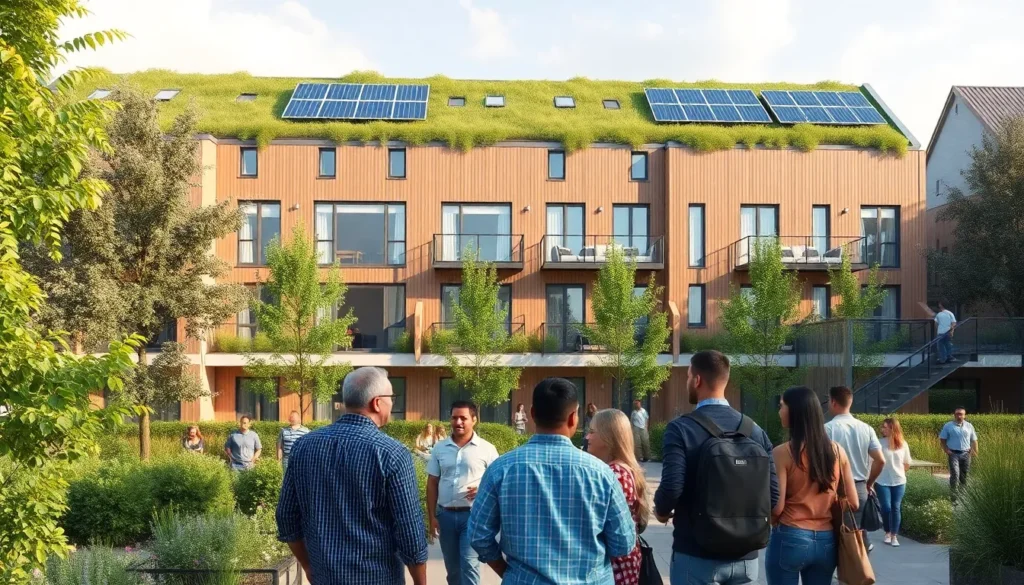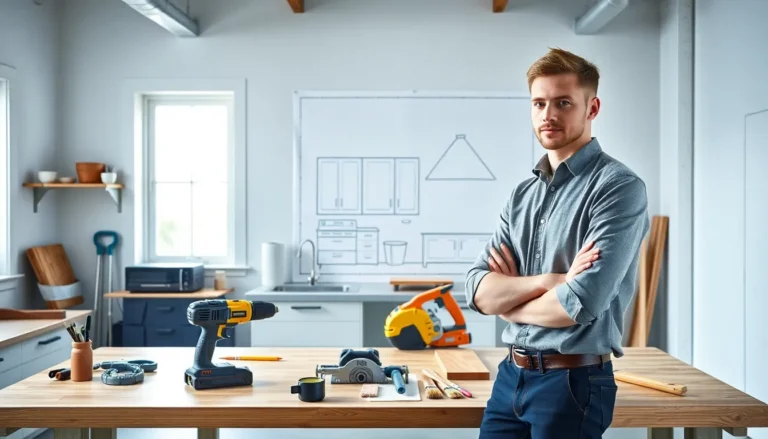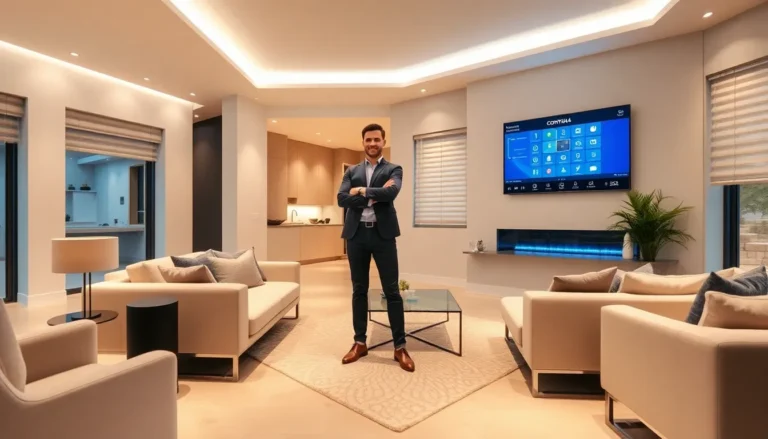Table of Contents
ToggleIn a world where buildings are no longer just four walls and a roof, architecture trends are evolving faster than a cat meme goes viral. Today’s architects are blending creativity with sustainability, crafting spaces that not only look good but also make Mother Nature proud. From eco-friendly materials to smart technology, these trends are reshaping the skyline and our way of living.
Imagine walking into a home that feels like a cozy hug while also being a tech-savvy fortress. It’s not just a dream; it’s the new reality. As design philosophies shift and innovation takes center stage, staying updated on the latest architecture trends is essential. Buckle up as we explore the fascinating world of modern architecture, where style meets substance and every structure tells a story.
Overview of Architecture Trends
Modern architecture focuses on innovation and adaptability. Eco-friendly materials such as reclaimed wood and recycled steel dominate current projects. Smart technology plays a significant role, with homes featuring integrated systems for energy efficiency and security.
Sustainable design practices shape new building methods. Green roofs and living walls are increasingly common, providing natural insulation and improved air quality. Biophilic design enhances human connection to nature, incorporating natural light and outdoor spaces into urban environments.
Minimalism remains a prominent trend, emphasizing clean lines and functional spaces. Open floor plans offer flexibility, catering to diverse lifestyles. A neutral color palette often complements this style, creating a sense of calm.
Mixed-use developments gain popularity, combining residential, commercial, and recreational spaces. These projects foster community engagement and reduce reliance on transportation. Urban revitalization through adaptive reuse transforms old structures into vibrant hubs.
Incorporation of local cultures and traditions influences contemporary designs. Architects embrace regional materials and craftsmanship, promoting a sense of place. Collaborative spaces facilitate interaction, reflecting the growing demand for social connectivity.
Overall, architecture trends prioritize sustainability, community, and aesthetic appeal. Continuous innovation drives designs that enhance both functionality and comfort. Emerging technologies promise further evolution in architecture, shaping the future of our built environments.
Sustainable Design

Sustainable design plays a crucial role in modern architecture. Increasingly, architects prioritize environmental impact through innovative practices and materials.
Eco-Friendly Materials
Ecologically responsible materials redefine construction. Reclaimed wood provides aesthetic value while reducing deforestation, and recycled steel offers durability without the environmental toll. Additionally, bamboo stands out as a fast-growing alternative celebrated for its strength and renewability. Adopting these materials not only minimizes waste but also promotes a circular economy in the building industry. By incorporating salvaged components, designers can create spaces with unique character while supporting sustainability.
Energy Efficiency
Energy efficiency becomes essential in sustainable architecture. Smart technology streamlines energy consumption through automated systems that adapt to occupant needs. Incorporating solar panels allows buildings to harness renewable energy, decreasing reliance on fossil fuels. High-performance insulation technology significantly reduces heating and cooling demands, ultimately resulting in cost savings and lower carbon emissions. Implementing energy-efficient designs benefits both the environment and homeowners, fostering a commitment to sustainable living.
Technological Innovations
Technological innovations significantly influence current architecture trends, enhancing both function and aesthetics.
Smart Buildings
Smart buildings integrate advanced technologies to optimize energy use, security, and comfort. Automated systems control lighting, heating, and cooling, adapting to occupants’ preferences. These buildings often utilize sensors to monitor environmental conditions, improving indoor air quality and reducing energy costs. For instance, smart thermostats learn usage patterns, resulting in efficient energy consumption. Additionally, solar panels play a key role in energy independence, contributing to lower utility bills. Architects increasingly design with smart technology in mind, creating efficient, user-friendly environments that promote sustainability.
3D Printing in Architecture
3D printing revolutionizes construction processes by enabling rapid prototyping and cost-effective material usage. Architects use this technology to create complex designs that may be challenging with traditional methods. As a result, building components are produced on-site, minimizing waste and transportation emissions. Various materials, including concrete and bio-based composites, enhance versatility in design possibilities. Additionally, 3D printing contributes to customizability, allowing for the creation of unique architectural features tailored to specific needs. This innovation paves the way for sustainable building practices, aligning with the growing demand for eco-friendly solutions.
Minimalism and Simplicity
Minimalism plays a pivotal role in modern architecture, emphasizing the importance of clean lines and uncluttered spaces. This approach fosters a sense of calm and clarity in living environments.
Open Spaces
Open spaces create a feeling of freedom and spaciousness. Many architects prioritize open floor plans, allowing natural light to flow throughout a home. These uninterrupted areas encourage flexibility in design and usage. Spaces that blend seamlessly, such as kitchens flowing into living rooms, enhance social interaction. The absence of excessive walls promotes a minimalist aesthetic while maximizing functionality.
Timeless Aesthetics
Timeless aesthetics underscore the beauty of simplicity in architectural design. By focusing on essential elements, architects create enduring spaces that withstand changing trends. Neutral color palettes, combined with natural materials, contribute to this aesthetic. Such designs often prioritize a connection to nature, enhancing overall well-being. A balance between form and function emerges, making minimalist architecture a wise choice for both style and sustainability.
Urban Renewal and Regeneration
Urban renewal focuses on revitalizing neglected or underutilized areas, transforming them into vibrant spaces. Architects play a crucial role in this process by designing projects that enhance connectivity and community engagement. Significant improvements occur in infrastructure, such as public transportation and green spaces, which promote accessibility and sustainability.
Regeneration strategies often prioritize mixed-use developments. These developments maximize land use by integrating residential, commercial, and recreational facilities. Examples include repurposed warehouses that become trendy apartments or community centers. The shift encourages social interaction and reduces dependence on private vehicles, contributing to lower carbon footprints.
Historic preservation integrates seamlessly into urban renewal efforts as well. Maintaining architectural heritage respects local history while providing a unique sense of place. Adaptive reuse of buildings showcases original architectural features, blending nostalgia with modern functionality. Upscaling existing structures minimizes waste and reinforces sustainability principles.
Green design elements significantly enhance urban regeneration. Urban parks, green roofs, and living walls improve air quality and create biodiversity hotspots. Community gardens foster local food production and provide educational opportunities, contributing to healthier lifestyles. Architectural projects increasingly incorporate biophilic design, which emphasizes the relationship between people and nature.
Collaborative efforts among architects, city planners, and communities ensure the success of urban renewal initiatives. Stakeholder engagement helps understand the diverse needs of residents, leading to more inclusive planning processes. Effective urban regeneration promotes social equity, economic viability, and environmental stewardship, cultivating vibrant cities for future generations.
The future of architecture is bright and filled with possibilities. As trends evolve architects are embracing sustainability and innovation to create spaces that resonate with both functionality and beauty. The integration of smart technologies and eco-friendly materials is not just a trend but a necessity for a more sustainable future.
By prioritizing community engagement and adaptive reuse architects are transforming urban landscapes into vibrant hubs that foster social interaction. This shift towards minimalism and biophilic design enhances the quality of life while respecting the environment.
As these trends continue to shape the architectural landscape they pave the way for a more connected and sustainable world. The commitment to improving living spaces reflects a growing awareness of the importance of design in enhancing human experiences.







